 |  | |||||||||||||||||||||||||||||||||||||||||||||||||||||||||||||||||||||||||||||
| The goal: 100 mpg at 70 mph, into a 20 mph headwind, with four bags of groceries. | ||||||||||||||||||||||||||||||||||||||||||||||||||||||||||||||||||||||||||||||
| Chap. 27: More Ideas for Starting Over | ||||||||||||||||||||||||||||||||||||||||||||||||||||||||||||||||||||||||||||||
| It is easy to get 100 mpg. Just ride a 50-cc, 4 hp machine. But can you actually go 70 mph, into a 20 mph headwind, sitting up and comfortable carrying the groceries and get 100 mpg with 50cc? | ||||||||||||||||||||||||||||||||||||||||||||||||||||||||||||||||||||||||||||||
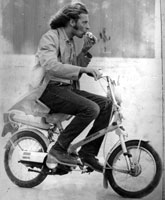 | ||||||||||||||||||||||||||||||||||||||||||||||||||||||||||||||||||||||||||||||
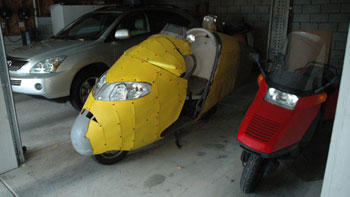 | ||||||||||||||||||||||||||||||||||||||||||||||||||||||||||||||||||||||||||||||
| There I am in 1977, eating pizza and getting 100 mpg | ||||||||||||||||||||||||||||||||||||||||||||||||||||||||||||||||||||||||||||||
| In a garage full of machines, would such a machine be our first choice? | ||||||||||||||||||||||||||||||||||||||||||||||||||||||||||||||||||||||||||||||
| Things we still don't know: Should it have a small engine spinning fast? Or should it have a big engine turning slower? Is it better to begin with a motorcycle that really gets 100 mpg, but at slower speeds, and streamline it so it will go 70 mph? Or - should we begin with a 65 mpg machine, like a BMW GS650, and streamline it, expecting the mileage will get better? Nobody knows. You are helping by providing bits and pieces from your unique knowledge: | ||||||||||||||||||||||||||||||||||||||||||||||||||||||||||||||||||||||||||||||
| After a year, we still do not have definitive answers! | ||||||||||||||||||||||||||||||||||||||||||||||||||||||||||||||||||||||||||||||
| Steve suggests we operate the engine at "Just above" peak torque. | ||||||||||||||||||||||||||||||||||||||||||||||||||||||||||||||||||||||||||||||
| April 13, 09, Steve wrote: Agricultural and commercial engines typically operate with a govenor set just above the torque peak. BSFC is the amount of fuel burned for the power produced. (Craig notes: Typical gasoline consumption is 1/2 pound of gas per horsepower per hour.) Any internal combustion engine operating at it's torque peak is producing the most power for the amount of fuel burned. But larger displacement engines in a mild state of tune are more efficient up to the torque peak. A diesel engine has a lower BSFC (Brake Specific Fuel Consumption) at it's torque peak than a gasoline engine. | ||||||||||||||||||||||||||||||||||||||||||||||||||||||||||||||||||||||||||||||
 | ||||||||||||||||||||||||||||||||||||||||||||||||||||||||||||||||||||||||||||||
| Craig notes: Typical Diesel consumption is 3/8 pound of Diesel fuel per horsepower per hour. | ||||||||||||||||||||||||||||||||||||||||||||||||||||||||||||||||||||||||||||||
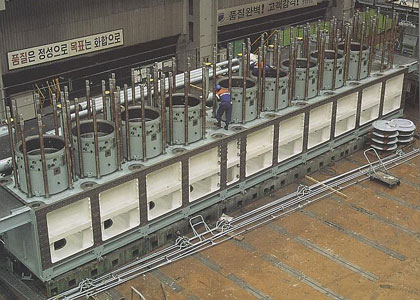 | ||||||||||||||||||||||||||||||||||||||||||||||||||||||||||||||||||||||||||||||
| But look at this: The Giant Wartsila-Sulzer RTA96-C from Aioi Works of Japan's Diesel United, Ltd. (that is a man in there between the cylinders) Fuel consumption at maximum power is .278 lbs per hp per hour (Brake Specific Fuel Consumption). Fuel consumption at maximum economy is 0.260 lbs/hp/hour. | ||||||||||||||||||||||||||||||||||||||||||||||||||||||||||||||||||||||||||||||
| Does this mean that a bigger, slow turning engine is likely to burn less fuel? Maximum power: 108,920 hp at 102 rpm Maximum torque: 5,608,312 lb/ft at 102rpm This thing burns "heavy fuel oil" which may have more BTU content. (Sometimes we can understand the problem better if we look at extremes.) | ||||||||||||||||||||||||||||||||||||||||||||||||||||||||||||||||||||||||||||||
| Steve also suggested: Place the engine behind the rider, with the riders toes even with the back of the front tire with the steering centered. | ||||||||||||||||||||||||||||||||||||||||||||||||||||||||||||||||||||||||||||||
 | ||||||||||||||||||||||||||||||||||||||||||||||||||||||||||||||||||||||||||||||
| Craig comments: Maybe not. You can sit too low! See below: | ||||||||||||||||||||||||||||||||||||||||||||||||||||||||||||||||||||||||||||||
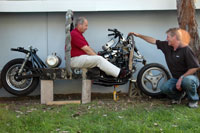 | ||||||||||||||||||||||||||||||||||||||||||||||||||||||||||||||||||||||||||||||
| April 14, 09 Tom pointed out: Low cg with motor and seat in the rear cause problems with front wheel lockup (not enough pitching force to load the front tire). Yes, you sharp eyed reader, that is Mr. Center-Hub - Steering Tony Foale sitting there. | ||||||||||||||||||||||||||||||||||||||||||||||||||||||||||||||||||||||||||||||
| Aug. 26, 2009, Steve gives some insight: "Id like to comment on this content found in Chapter 27:
| ||||||||||||||||||||||||||||||||||||||||||||||||||||||||||||||||||||||||||||||
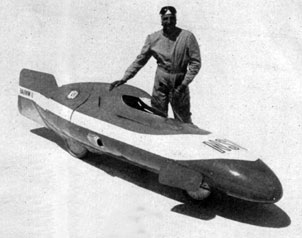 | 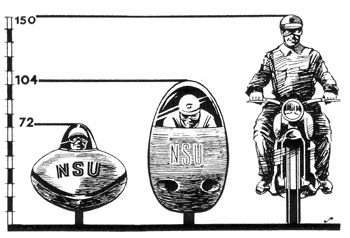 | |||||||||||||||||||||||||||||||||||||||||||||||||||||||||||||||||||||||||||||
 | Craig replies: Thank you, Steve. I love this stuff. However, we must consider yet another factor: Seeing the road ahead. The above pics are of a 50cc NSU streamliner, playfully referred to as the "Flying Hammock". Its designer, Gustav Baumm riding it while practising on the Nurburgring in 1955, crested a hill, assuming the track went straight. It didn't. How could he tell? He was sitting naerly on the track. Look at the daigram above. The pavement turned and he was killed as he plowed into some trees. Baumm was too low to see the road ahead. The point is: We can sit too low. | |||||||||||||||||||||||||||||||||||||||||||||||||||||||||||||||||||||||||||||
| Ted likes the Hayes' Diesel: | ||||||||||||||||||||||||||||||||||||||||||||||||||||||||||||||||||||||||||||||
| April 14, 09, Ted continues: As I stated before I would VERY MUCH like to get my hands on one of Freds diesel engines. It would change my Ninja 250 Alligator idea I mentioned last month to the diesel Alligator Photoshop you posted on your web page. The other small 25ish HP diesel engines in the US by Kohler, Briggs, or Chinese bad copies of Yanmar, all are rather heavy or poor quality (the Chinese knockoff) and not sure about emissions. The Ninja or Rebel frames are steel, so easily modified compared to an aluminum frame. I feel most any donor bike or scooter will need some modifications to fit your needs Any chance to get Fred to sell just an engine and transmisson? I can build a frame and would most likely remove it from a KLR chassis anyway. Can his motors handle biodiesel without problems? My choice of gas engines are similar to what others have said. Googling bikes for MPG and hwy speed turns up Rebel 250, Honda dual sport, ninja 250, BMW 650. The 87-07 Ninja has the best aero of most any bike from what I hear. Torque makes for easier to drive though. Comet makes several CVT transmissions that can be tuned better than the factory Honda CVT if you want an automatic. I cannot ask for an electric vehicle. I already crunched the numbers on an electric car for my major project back in college. The power storage technology in batteries, capacitors, fuel cells, etc., is just not available for the range I or people in the hills of East Tennessee need. We have terrible sprawl. If the idea is for a freedom machine and not just a freedom motorcycle, don't overlook a well thought out reverse trike for hybrid drive. Use an AC or SepEx DC motor driving the front wheels and a small gas or diesel powering the rear. Electric in front for regen. A trike can accept the rain drop shape needed to get the CD small. Already designed trikes of note being the Aptera (wish it was hybrid and not just electric and they would sell outside of Cali) the XR3 kit/home built by RQ Reiley, and the one not really a trike. The VW 1 liter every 100 kilometer car. It is more a 4 wheel enclosed motorcycle. seats 2 and 2.8 cubic foot of storage space. Of course all of them could be marketing hype. I do admit the downside to building one is the time and design detail needed most likely wont get you driving it this year. Also much more costly. So, back we go to Fred's diesel in the Harley scooter chassis, wrapped in your fairing. Do you still have that chassis around? If not, how fast could you get one built? Next choice would be a water cooled 250 or BMW 650 to power the scooter so you can plumb the radiators into better airflow instead of trying to get airflow over an air-cooled engine burried in there somewhere. Thanks, just trying to hit the high points and most likely missing some details. The devil is in the details. | ||||||||||||||||||||||||||||||||||||||||||||||||||||||||||||||||||||||||||||||
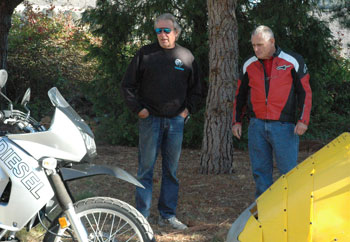 | ||||||||||||||||||||||||||||||||||||||||||||||||||||||||||||||||||||||||||||||
| Fred Hayes says that his Diesel will be most efficient at "just under its max torque" rpm. These are all clues for us. | ||||||||||||||||||||||||||||||||||||||||||||||||||||||||||||||||||||||||||||||
| Vetter and Hayes pondering a Diesel future | ||||||||||||||||||||||||||||||||||||||||||||||||||||||||||||||||||||||||||||||
| April 13, 2009, Raymond writes: Hi Craig Good to see you persevereing with this. I imagine there are many ways to get to where you want to go. I think both gearing and streamlining are important, so whatever you get should be capable of having the final drive ratio adjusted so the engine is in its peak efficiency range for the vehicle speed. Engine SFC can fall off dramatically on either side of the best RPM, depending upon the engine and its tuning. Streamlining applies to all parts of the vehicle, so can be more complex than simply rounded in front and pointed at the rear. The wheels should be aero (i.e. discs), the underside needs to be clean (i.e faired), the airflow around any bumps or seams should be clean and stepped down (not up wrt the local flow). The surfaces should be wave free and have no tendency to vibrate at speed. All of these details can easily add up to more drag than the fairing is saving. Just one approach can be seen here: http://www.wisil.recumbents.com/forums/topic.asp?TOPIC_ID=2515 For my trike, we used approximately 400-450 watts avg (.54-.60 hp) to reach 66mph. With a small gas motor with a resonably good SFC of say .5 lb_fuel/hp*hr, this would equate to 1320-1460 mpg at that speed: http://www.vimeo.com/1892418 Orion Speedtrike http://www.recumbents.com/WISIL/gage/orion_speedtrike.htm | ||||||||||||||||||||||||||||||||||||||||||||||||||||||||||||||||||||||||||||||
| April 13, 09. Azhar writes: Time to marry up Streamlining with some lightening. Go Electric. (Azhar is hosting the electric motorcycle race on the Isle of Man this June) | ||||||||||||||||||||||||||||||||||||||||||||||||||||||||||||||||||||||||||||||
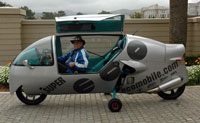 | ||||||||||||||||||||||||||||||||||||||||||||||||||||||||||||||||||||||||||||||
| Dan wants an electric Ecomobile. Dan is an owner and driver of an Ecomobile. He says: | ||||||||||||||||||||||||||||||||||||||||||||||||||||||||||||||||||||||||||||||
| The best possible design so far has been done by Roger Reidener in Switzerland email "baumarketing@bluewin.ch" . He has taken an ECOMOBILE and powered it with a special lithium polymer battery array which is computer managed (not real sure of the details yet) and drives a 200hp AC electric motor (from California) through an inverter which is very close to 100% efficient. At the ECO BRNO event last year, he outran all competitors (except two turbo models). Has great comfort with all the room and trunk space needed for two. He claims 300 miles on a battery charge @50MPH and 200MPH+ top speed. And less than a penny a mile fuel cost in Switzerland (where it is very expensive). | ||||||||||||||||||||||||||||||||||||||||||||||||||||||||||||||||||||||||||||||
 | ||||||||||||||||||||||||||||||||||||||||||||||||||||||||||||||||||||||||||||||
| Craig comments: I like the idea of measuring travel in "Cost per Money" | ||||||||||||||||||||||||||||||||||||||||||||||||||||||||||||||||||||||||||||||
| For example, if gas is $2.50 per gallon and we can get 100 mpg, it would cost 2.5¢ per mile. The summer of 2008, with gas at $4.50 per gallon, it would be 4.5¢ per mile. 1¢ per mile? At 70 mph, into a 20 mph headwind? I don't believe it. | ||||||||||||||||||||||||||||||||||||||||||||||||||||||||||||||||||||||||||||||
| Why EFI is better than than a Carb: | ||||||||||||||||||||||||||||||||||||||||||||||||||||||||||||||||||||||||||||||
| April 13, 09, From Jim: I generally try to avoid complexity for its own sake however, the use of computer injection provides more mixture precision over the full range of engine operation than carburetor equipped systems. Response to and control of variables such as temperature, barometrics, air fuel mass flow and on and on it goes is a good thing. Equivalent control of carburetor equipped engines is a blessing not so easily attained. Direct injection, programmable ignition, variable cam and even better full electronic valve timing provide more power and better potential for efficiency over carburetors. All of this control is a tremendous boon up to the point some little electronic widget goes pop in the middle of a great ride bringing it all to a proverbial halt. It is at this point that a carburetor begins to appear more attractive. When you consider the potential all of this control offers a "tuner" the conclusion seems obvious. | ||||||||||||||||||||||||||||||||||||||||||||||||||||||||||||||||||||||||||||||
| Grant agrees - We need two different vehicles: | ||||||||||||||||||||||||||||||||||||||||||||||||||||||||||||||||||||||||||||||
| April 13, 2009 From: Grant: Thanks for the heads up. I believe you are right that two different missions are in play here. A streamlined electric bike is a short distance vehicle for the daily trips and would piggy back with a bus, car, or train. Long distance two passenger cruisers would be fully enclosed monocoque designs resembling a glider fuselage. Either a two or three wheel layout would work powered by a 3 cyl. diesel engine and a 3 phase electric motor. There are some kits on the market that could be starting points if side by sideseating is prefered. | ||||||||||||||||||||||||||||||||||||||||||||||||||||||||||||||||||||||||||||||
| Billy likes Alcohol as fuel: | ||||||||||||||||||||||||||||||||||||||||||||||||||||||||||||||||||||||||||||||
| April 15, 2009 2:52:29 PM Billy W writes: I admire your perserverance on getting fuel economy and streamlining. If you sorted the project out and got it to sell, how many people would be interested to buy one. 1/2 of one percent of the people who drive maybe even 1 percent of the drivers out there and thats alot. what if you could do something that would help 100 percent of drivers out there. does it sound impossible, it isnt. the one thing that we all put in our vehicles is fuel. without fuel we dont go anywhere. i watched your clip about you saying how much fuel the usa imports. you have all the fuel that you need in the usa and an inexhaustable supply of it. the fuel is alcohol and you have the best authority on alcohol that there is in california. alcohol gives out zero emmisions but there are a few problems with it. David Bloom, has wrote a book called alcohol can be a gas. There is also a couple of clips of him being interviewed on youtube: http://www.youtube.com/watch?v=Jew3ah24Zj4 also part two http://www.youtube.com/watch?v=9vq7km9TWL0 If you do have a look on the coates rotary valve website, i would recomend that you have a look at this video. cheers. billy. http://www.coatesengine.com/videos.html# | ||||||||||||||||||||||||||||||||||||||||||||||||||||||||||||||||||||||||||||||
 | ||||||||||||||||||||||||||||||||||||||||||||||||||||||||||||||||||||||||||||||
| Craig replies to Billy: I don't think I am heading towards producing any vehicle, Billy. I am just developing functional streamlining that can help reduce the use of energy, no matter where that energy comes from. | ||||||||||||||||||||||||||||||||||||||||||||||||||||||||||||||||||||||||||||||
 | ||||||||||||||||||||||||||||||||||||||||||||||||||||||||||||||||||||||||||||||
| If Alcohol is made from corn... Frankly, I would rather eat the corn. | ||||||||||||||||||||||||||||||||||||||||||||||||||||||||||||||||||||||||||||||
| John presents some good reasons for beginning again with a Suzuki Savage | ||||||||||||||||||||||||||||||||||||||||||||||||||||||||||||||||||||||||||||||
| April 14, 09: John says: I tend to be in the large(r) single camp with this rather than the more marginally-powered smaller engine group. To my mind, the 'advantage', if any, of a 650 single powered streamliner would be in it's ability to be over-geared for the relatively low enginespeeds desired for fuel economy, while retaining the 'headroom' to be downshifted for an emergency spurt of power should it be needed while still offering the potential for exceptional fuel mileage at a more sedate pace. | ||||||||||||||||||||||||||||||||||||||||||||||||||||||||||||||||||||||||||||||
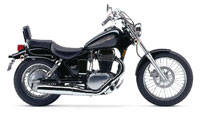 | ||||||||||||||||||||||||||||||||||||||||||||||||||||||||||||||||||||||||||||||
| One possible candidate as a new donor bike in the 650 displacement range that hasn't yet been mentioned is the little Suzuki 650 'Savage' cruiser. This machine has a belt final drive and a relatively low 27 inch seat height, has been around for quite a few years with little change and is therefore plentiful and quite inexpensive to buy on the used market ( I think they're only around $4500 new so $2500-3000 should pick up a clean used example for experiement). It also has forward foot controls. It is air-cooled (air/oil?) however, and I don't know if this presents a problem in the fully-faired configuration of your streamliner concept, though you must still accomodate the airflow to the radiator of a liquid-cooled machine so maybe this is a 'wash' either way. This engine is on the lower end of the typical, modern, 650 single horsepower spectrum and is probably more suitable in that regard than either the somewhat higher-powered 650 BMW and KLR singles. I'm not fan of cruisers in general, but this bike might fit the requirements more readily than some others being considered, and is likely an easier adaptation to create a fuel-busting streamliner from as it's already fairly low and mechanically simpler from the outset. Happy streamlining! | ||||||||||||||||||||||||||||||||||||||||||||||||||||||||||||||||||||||||||||||
| April 28, 2009: Terry writes: After some though, my idea of the perfect engine for this project is a 400 cc single cylinder (or a comparable displacement vertical twin) that has pretty much the same proportional dimensions, valves, and cam timing as one cylinder from the 1994 Honda Civic VX. 7.7 cc bore, 8.66 cc stroke, 9.3:1 compression ratio, 4 valves. This is a somewhat little known model that was rated at 50 mpg. http://www.fueleconomy.gov/FEG/noframes/10747.shtml The Civics usually run about 3300 rpm at 70 mph in 5th gear but get the best mileage between 55 mph and 65 mph. Geared so it turns just under 3000 rpm at 70 mph in a low Cd motorcycle, I think an engine of this size would (hopefully) have a little headroom so it did not have to run at full throttle. It should put out pretty close to the 15 ft lbs of torque with the right valve and cam design but I am not sure that it works out to enough horsepower at 3000 rpm. It could need a 500 cc engine to make enough power at this comparably low rpm. I looked at over a dozen motorcycle and scooter engines between 200 cc and 500 cc. They all seem to be oversquare (larger bore diameter than stroke) high rpm and the motocross/offroad have high compression designs (over 11.0:1). I think an undersquare engine with higher torque at a lower rpm will give better mileage. Very few motorcycles or scooters have an advertised number over 70 mpg. I think this is because they are all oversquare designs. My guess is it has to do with the thermodynamics of an undersquare cylinder having a longer expansion stroke for a given displacement so you get more energy out of it. Higher rpm motors also seem to need more maintenance, like more frequent oil changes and more frequent valve adjustment. | ||||||||||||||||||||||||||||||||||||||||||||||||||||||||||||||||||||||||||||||
| May 3, 2008 Mark restates the dilemma: I've been reading the letters and comments on what bike you should use for the next phase of the streamline project, and there seems to be quite a trend towards higher displacement, and possibly switching to a motorcycle. I don't get it. I think you were doing some very clear thinking in picking a 250cc Helix for phase 1. Your results proved that it has just about the right power vs. fuel consumption balance. The shortcoming was the stability of the bike at high speed and the gearing of the transmission that prevented the streamlined bike from achieving the higher speeds that the engine was capable of providing. Replacing the Helix' small wheels with proper 16 inch wheels would address both issues. The response curve of a CVT is easily modified by changing a few inexpensive roller weights and springs, but the final gear ratio is not - but can be achieved by changing to a larger wheel. The increased gear inches achieved with larger tires on the Helix should give you sufficient top end to go 75 comfortably, with the added "big wheel" stability you are seeking. But the goal is to make a bolt-on streamlining kit, not to have to heavily modify or fabricate a new scooter chassis to fit large wheels on a small wheel bike. Also, quite frankly I don't think any motorcycle frame is going to achieve the comfort and roominess you are looking for inside a small full streamlined shell, you need to stay with a scooter. There are a number of big wheel 250cc maxi-scooters to choose from - and quite a few more if you count the ones that the major brands won't sell in the USA. But if you stick with what is commercially available in the US something like the very affordable and high quality Kymco People 250 might fill the bill - in stock form it gets 70mpg and it reported to top out at just under 80mph. Other contenders would be the Scarabeo 250 or the Piaggio BV250 - I know, the 500cc versions of these two scoots have been suggested, but I just don't believe the 500's are going to achieve the mpg you are looking for, despite rumors of "sweet spot" efficiency at half throttle. Now I know that getting a stock 250 big wheel scooter might not achieve that taller final gear ratio that slapping a 16 inch wheel on a Helix would acheive - because their CVT's are spec'd for a 16 inch wheel. But if that final gear ratio isn't tall enough ... I wonder what would happen if you replace it with the CVT from a Helix? | ||||||||||||||||||||||||||||||||||||||||||||||||||||||||||||||||||||||||||||||
 | ||||||||||||||||||||||||||||||||||||||||||||||||||||||||||||||||||||||||||||||
| Craig says: I am getting closer to a new platform. This time help may come from a manufacturer instead of EBAY. | ||||||||||||||||||||||||||||||||||||||||||||||||||||||||||||||||||||||||||||||
| May 7, 2009, David wrote: I was thinking that the very short travelling range that people get out of electric motorcycles could be greatly extended if they had the same streamlining that allowed the gasoline bikes to be pushed along with just a few horsepower. If a bike only needed 3-5 HP instead of 15-25 horsepower to keep it going at highway speeds, Vetter clarifies: Well, that was when speed limits were 55 and the rider was all squished into a tiny shell. Sitting up and comfortable at 70 mph means more like 15 hp. the range of an electric motorcycle could be tripled, quadrupled, or even better. just like the gas mileage improvements. Vetter comments: You are right. Electric vehicles need to begin with streamlining! If an extra power pack could be added for longer trips to extend the range even further, the electric motorcycle could become an attractive method of transport. At least for me anyway. I was thinking of the possibility of pulling an easy-towing add-on battery pack for longer trips either in the form of a narrow fin-shaped one-wheel backpack style trailer, or in the form of a "pusher-trailer" that also added it's own electric motor to help push the bike along in addition to the extra battery power. | ||||||||||||||||||||||||||||||||||||||||||||||||||||||||||||||||||||||||||||||
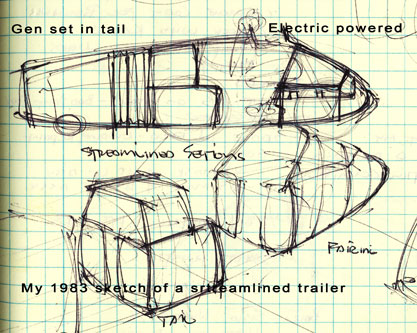 | ||||||||||||||||||||||||||||||||||||||||||||||||||||||||||||||||||||||||||||||
 | ||||||||||||||||||||||||||||||||||||||||||||||||||||||||||||||||||||||||||||||
| Vetter says: I think for extended trips, it should be a 3-8 hp Diesel gen set towed behind an electric bike, streamlined like the above sketch. Run an extension cord to the tow bike. That way, you could actually stop, take a nap and recharge yourself in order to get to an electrical outlet. Actually, we would be better off developing solar powered recharge stations... or battery exchange stations to serve the function of gas stations | ||||||||||||||||||||||||||||||||||||||||||||||||||||||||||||||||||||||||||||||
I was thinking that if the power-supply trailer itself added a little forward push, then the bike itself wouldn't have to be overbuilt with a heavier motor than it needed for the short in town errands. Only for long trips would it need the extra push, when it was pulling extra battery packs. When the bike was all by itself running in-town errands, it wouldn't need to be lugging around a heavier motor. Does that sound reasonable? They would be incomplete shapes by themselves. but that is OK. The front would be for around town, generally slow. the rear gen set would complete the streamlining for the road where streamlining is more important. Does it make a little better sense saying it this way? Vetter says: I think the solution is in the above sketch. Is it more effective to have one complete streamliner "drafting" behind another complete streamliner, or is it better to blend both together into one single long streamliner? (may flex in the middle at the trailer hitch) Here is A GREAT DESIGN PROBLEM: The connection between the tow vehicle and the trailer: How do you articulate it and keep it smooth? You just might be the person to come up with the Great Solution. | ||||||||||||||||||||||||||||||||||||||||||||||||||||||||||||||||||||||||||||||
| Its Show Time! | ||||||||||||||||||||||||||||||||||||||||||||||||||||||||||||||||||||||||||||||
| Quail Lodge in Carmel is having its first Motorcycle Concourse and the AMA Vintage Days in Ohio is coming up next. Time to freshen up the Freedom Machine. The tail is looking a little tired. OriginallyI I had assumed that I would deflate it and stow it away for most riding. But, the tail is cool. So, I leave it on all the time. For the upcoming shows, I need to make it prettier. | ||||||||||||||||||||||||||||||||||||||||||||||||||||||||||||||||||||||||||||||
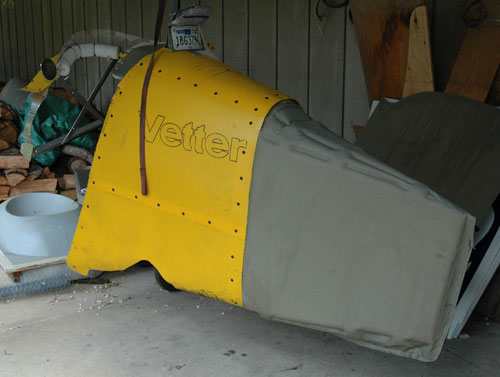 | 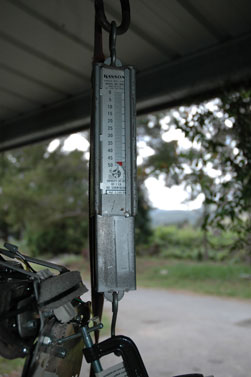 | |||||||||||||||||||||||||||||||||||||||||||||||||||||||||||||||||||||||||||||
| While I had the body off for maintenance, I weighed it: 48 pounds. Not bad. | ||||||||||||||||||||||||||||||||||||||||||||||||||||||||||||||||||||||||||||||
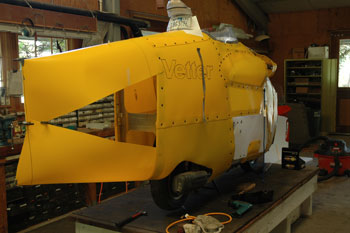 | 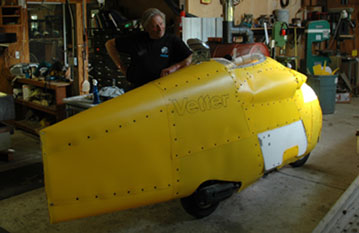 | |||||||||||||||||||||||||||||||||||||||||||||||||||||||||||||||||||||||||||||
| The new yellow plastic tail weighs the same 3 pounds. It is prettier all one color. | ||||||||||||||||||||||||||||||||||||||||||||||||||||||||||||||||||||||||||||||
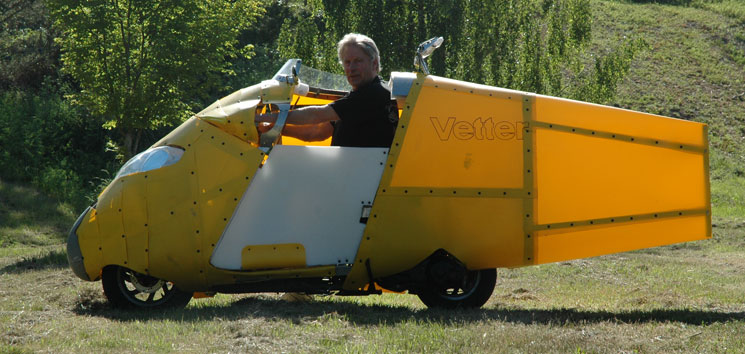 | ||||||||||||||||||||||||||||||||||||||||||||||||||||||||||||||||||||||||||||||








